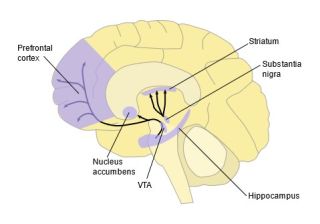Addiction
Pharmacokinetics and Addiction
Addiction potential is related to how fast the drug affects brain function.
Posted November 29, 2023 Reviewed by Kaja Perina
Key points
- Pharmacokinetics, or the movement of drugs in the body, affects the probability of addiction to that drug.
- Fast entry of the drug into the brain tends to make the drug more addictive.
- The salience network in the brain is activated by IV injection of a drug, but not by oral administration.

Remember that 20th century ad on TV about drug addiction that compared your brain on drugs to a fried egg? Addiction starts with the brain. The drugs that produce addiction are called “psychoactive” meaning they have a physical effect because they change the way the brain works. Obviously, that means a given drug must be able to be absorbed into the brain.
The speed of action a drug has in the CNS is positively correlated with its addictive potential – the faster the drug gets to your brain, the more addictive that drug tends to be. One important factor in determining speed of action of a drug is its “route of administration” or the method by which the drug enters your body. Intravenous administration, injecting it directly into the blood stream is one of the fastest methods, taking only seconds to have an effect. Taking a pill orally is one of the slowest methods; it can take as much as half an hour for a pill we swallow to produce an effect (Julien, 1995).
Researchers have known about the speed of action and addiction link for a long time. However, the reason for this link was unknown. Manza, Thomasi, et al., 2023 were interested in studying the interaction between the route of administration of a drug, and the way the brain responded to the drug.
To find out, they conducted a double-blind study asking people to take methylphenidate (aka Ritalin), a CNS stimulant usually used to treat ADHD, ADD, or a placebo either orally or via injection. Participants were also asked to report on their experience with the drug, using a scale from 1 to 10 to rate how “high” they felt, while undergoing PET/fMRI scanning.

Many drugs with addictive potential, Ritalin among them, affect the function of cells in the reward system in the brain (Hobkirk, Bell, Utevsky, Huettel and Meade, 2019). The reward system is what makes us feel pleasure. All kinds of things make us feel good – succeeding at something we’ve been working toward, spending time with the people we love, eating foods that we love, all stimulate the reward centers of the brain and make us want to repeat the behaviors that led to that feeling of pleasure.
Even behaviors that are massively unhealthy for us, that shorten our lives and cut us off from the people and experiences we love in the world, can trigger the reward system and make us feel euphoric and “high.” The drugs that humans abuse, that cause addiction, do so by directly stimulating that reward center. These drugs tell the cells in the reward center to release a neurotransmitter called dopamine (DA) and the release of DA feels good, so we repeat the behavior that led to its release and take more and more of the drug.
When it is released, DA binds to what are called “receptors” on other cells, telling these other cells to fire (an excitatory response) or to stop firing (inhibition). The response of the receptor to the binding of the neurotransmitter depends on the type of receptor itself. There are five different kinds of DA receptors in the brain (called DA1 through DA5). The two types of DA receptors important in this study are DA1 and DA2. The most common type of DA receptor is DA1. It is found in the reward circuitry, among other places, and plays a role in the feeling of being rewarded along with movement, memory, attention, and impulse control. DA2 receptors are primarily inhibitory in function, playing an important role in movement, memory, sleep, attention, and learning (Bhatia, Lenchner, and Saadabadi, 2023).

Ritalin also affects DA2 receptors found in another network, the “salience network.” We use the salience network to identify what is important (or salient) both inside and outside of our bodies and to direct our attention to those stimuli. Drugs that affect this network might be changing how we experience the internal physical effects of a drug – the “high” the drug produces. So a drug that affects the reward system would have an impact on what we find to be pleasurable, and one that affects the salience network would change how we pay attention to the world.
Manza, Thomasi et al., found that the route of administration had an effect on the cognitive experience of taking the drug. When Ritalin was administered via injection, DA levels, measured via the PET scans, went up very fast, peaking within 5 to 10 minutes of injection. The rating of how the drug made the participant feel also went up very quickly. Oral administration of the drug resulted in a slow increase in DA levels, taking up to an hour to reach a maximum, and ratings of the feeling of being “high” were much lower.
Where the drug had its effect was also a factor, monitored in this study using fMRI imaging. These scans showed that the salience network was only activated by intravenous injection of the drug; oral administration did not activate this system. So, the fast rise of DA levels seen after injection of the drug was associated with increased activity in a different part of the brain. This effect was consistently seen in all 20 participants in the study. The increased risk of addiction that accompanies injection directly into the bloodstream may have to do with activation of this salience network and how we direct our attention. The authors suggest that finding a way to inhibit the salience network might lead to new therapies against drug addiction.
References
Bhatia A, Lenchner JR, Saadabadi A. Biochemistry, Dopamine Receptors. 2023 Jun 22. In: StatPearls [Internet]. Treasure Island (FL): StatPearls Publishing; 2023 Jan–. PMID: 30855830.
Hobkirk, A.L., Bell, R.P., Utevsky, A.V., Huettel, S., and Meade, C.S. (2018). Reward and executive control network resting-state functional connectivity is associated with impulsivity during reward-based decision making for cocaine users. Drug and Alcohol Dependency, 194, 32-39. Doi: 10.1016/jdrugalcdep.
Julien, R.M. (1995). A Primer of Drug Action: A Concise, Nontechnical Guide to the Actions, Uses and Side Effects of Psychoactive Drugs. 7th Edition, W.H. Freeman and Co., New York, New York, Oxford England.
Manza, P., Tomasi, D., Shokri-Kojori, E., Zhang, R., Kroll, D., Feldman, D., McPherson, K., Biesecker, C., Dennis, E., Johnson, A., Yuan, K., Wang, W-T., Yonga, M.-V., Wang, G-J., and Volkow, N.D. (2023). Neural circuits selective for fast but not slow dopamine increases in drug reward. Nature Communications, 14, 6408, doi.org/10.1038/s41467-023-41972-6.


